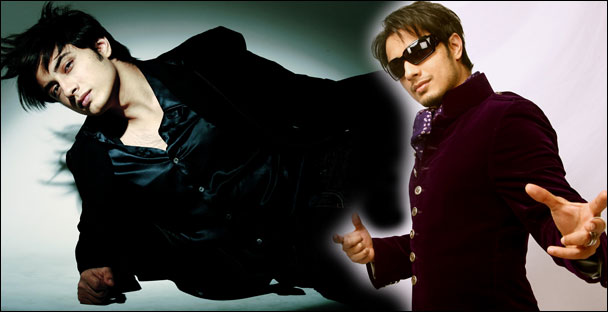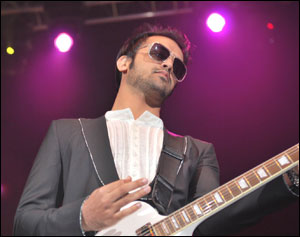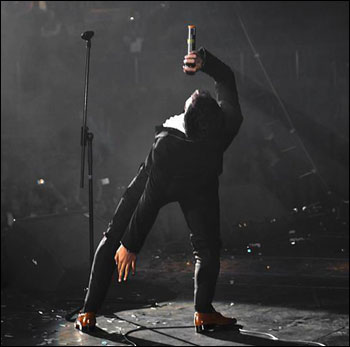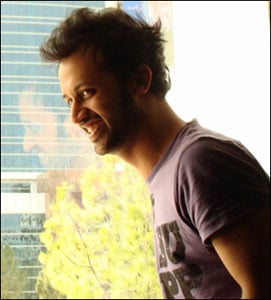|
Coming of age and into their own
The musical journey of Ali Zafar and Atif Aslam
Looking back and to the future of the brightest stars in Pakistani pop…
By Maheen Sabeeh
With every generation comes a change.

If music is a barometer, then this generation will be defined by two
men. Both are young, daring, different, vulnerable and ultimately
icons. Their names are splattered across blogs, forums, magazines and
billboards. Songs they sang years ago still live on in memory even as
they are incessantly repeated on television. They’ve charmed us
collectively with their respective voices that stay in our heads long
after the strains of their melodies fade. They have conquered hearts
and minds of Pakistan in way that Uncle Sam never can. Those men are
Ali Zafar and Atif Aslam.
Pakistan loves them because we have witnessed their journey from
boys to men. We woke up to their talent with Ali Zafar’s cheeky
‘Channo’ and Atif’s intense ‘Aadat’. One set our feet tapping, the
other resonated deep within us. Both melodies worked their way into our
heads and we new that a new kind of music had arrived.
If Alamgir, Nazia and Zoheb Hassan defined the eighties, Vital Signs
and Junoon were the voices of the nineties, than in the same vein, Ali
Zafar and Atif Aslam who surfaced in 2003 and 2004 respectively are the
stars of the new millennium.
Instep looks back…
Then and now: Atif Aslam
The story of Atif Aslam is an inspiring one. Atif was middle-class boy
who came out of nowhere, blew onto the scene with one song (‘Aadat’)
credited to a band called Jal which no one had really heard of and
miraculously never looked back.
As the ‘Aadat’ phenomenon grew (it was the era where Junoon was on
the rocks and Noori and Strings were really the only ones making
cutting edge music Atif parted ways with Jal (namely Gohar Mumtaz).
There was one consequence: his debut album was shrouded in controversy.
There were beautiful songs…’Jalpari’, ‘Dil Haarey’ and ‘Aadat’ but we
listened to these songs in wonder. And because of their popularity, the
controversy grew.
 Who
wrote it, really? Jal’s debut consisted of exactly the same songs. We,
the press, kept grilling the issue because it was interesting. A
certain level of cynicism is allowed in Pakistan… and could anyone be
certain? No, the real truth lies with Atif Aslam and former band mate
Gohar Mumtaz. But that was a long time ago. And since then, Atif has
proved his credentials time and again as a star and a talent to be
reckoned with. Who
wrote it, really? Jal’s debut consisted of exactly the same songs. We,
the press, kept grilling the issue because it was interesting. A
certain level of cynicism is allowed in Pakistan… and could anyone be
certain? No, the real truth lies with Atif Aslam and former band mate
Gohar Mumtaz. But that was a long time ago. And since then, Atif has
proved his credentials time and again as a star and a talent to be
reckoned with.
And he did it on gut instinct alone. Atif ventured into India where
doing songs for B-grade films didn’t bother him. It was his way of
reaching out to another audience, one that could choose to not welcome
him. But Atif was always confident… he would do it or die trying.
Whether it was Kalyug or Zeher, bad club mixes of Atif’s haunting
tracks or Emraan Hashmi killing the visuals, Atif didn’t stop.
He went one step further with Doorie, his second album. The album
was a super hit although it was painfully commercial stuff that sold on
the shoulders of Atif’s unmistakable voice. It wasn’t coming from him,
though. There was no ‘Kinara’ there. In an interview after the record,
Atif had said, "It’s more difficult to do commercial music like Doorie
because it is more challenging in a sense.” He was right. And at that
point in his career Atif wanted to sell records.
He believed that getting a fan base would allow him to do what he
really wanted to do later and he admitted that Doorie was music to sell
and not necessarily good music. Indeed, in his pursuit of fame and
fortune, Atif was as unabashed as the Indian superstar Shah Rukh Khan
who was the first star to openly claim that he would dance at weddings
for money. We may have criticized Atif for selling out, but we could
never call him a liar. Even back then, his honesty was endearing.
Then came Meri Kahani on which Atif teamed up with the Overload guys
Farhad Humayun, Mahmood Rehman and others. It didn’t have the magic of
Jalpari. And Atif’s vocal experiments in the studio didn’t have the
same effect. The record was, at least honest. And that was Atif
returning to his roots. Under heavy firing for his weird sense of style
(which has gotten better with time), unapologetic for his
not-so-inspiring tunes in his early days, the star of Atif Aslam
continued to rise.
In the music industry, Atif’s reputation even took a hit because of
his brother and manager Shabaz Aslam. Initial fashion disasters (Shabaz
is behind Atif’s wardrobe) weren’t the only reason. The brothers
developed a reputation of playing good cop and bad cop. There were
umpteen complaints about how pushy and demanding a manager Shabaz was,
but he obviously did a good job.
Now, this reputation has slowed down as Atif is coming in to his own. One example: Coke Studio.
As Atif Aslam joined the ranks of Coke Studio this year, the haze
around him disappeared altogether. Shahbaz didn’t even go on the sets
and Atif for once gave in completely to the joy of making music for
music’s sake. The musician in him danced and charmed, inspired and
experimented with some of the finest musicians this country has
produced and the rest is history.
Then and now: Ali Zafar
Ali Zafar’s story is equally interesting and intriguing.
He came and leaped at us as the blue-eyed boy in the entertaining
‘Channo’. It took Ali three years to work on that record. He modeled on
the side and worked his way up and worked with names like Tariq Amin,
Nabila and Khawar Riaz in his early years. To see him in his element,
you have to see Ali Zafar at a concert live. He changes sentiment from
song to song, singing both with his heart and his head. But before we
saw Ali Zafar mesmerize Pakistan with ‘Allah Hoo’, he was the boy who
made us dance and clap along with the spring in his step and the
twinkle in his eye and a voice that reminded us of Kishore Kumar.
The record Ali Zafar debuted with was called Huqa Pani and it took
influences from the Arabian nights, Western beats as well as Eastern
roots. It was a fun album to be taken with a pinch of salt, yet
masterfully executed. And there was no doubt that Ali’s voice was
eastern and beautiful and its purity would be reflected throughout his
music in the coming years.
 In
2006, Ali Zafar released the playful and soulful Masty, his follow-up
to Huqa Pani. 2006 is (ironically) also the year when Atif Aslam
returned with his third record, Meri Kahani. Doorie had elevated his
star power tremendously and Atif was arriving on its trailing coat
tails. It was an exciting year. For the first time, Ali and Atif were
going head to head. But Atif took the glory often because of his
self-confidence and the fact that he had three albums in a span of
three years to his credit and Bollywood was now calling out with more
than B-grade offers. In
2006, Ali Zafar released the playful and soulful Masty, his follow-up
to Huqa Pani. 2006 is (ironically) also the year when Atif Aslam
returned with his third record, Meri Kahani. Doorie had elevated his
star power tremendously and Atif was arriving on its trailing coat
tails. It was an exciting year. For the first time, Ali and Atif were
going head to head. But Atif took the glory often because of his
self-confidence and the fact that he had three albums in a span of
three years to his credit and Bollywood was now calling out with more
than B-grade offers.
Ali Zafar, on the other hand, was always a little more torn and
vulnerable. His career may have started like wild fire but he had seen
the firing of critics just the same. His career moves were also not as
gutsy as Atif’s. He was always concerned about his image and what
people would think – refusing a role in Shoaib Mansoor’s Khuda Kay Liye
because it was too controversial.
Ali (along with his then-girlfriend, now-wife Ayesha Fazli) was
abducted last year in Lahore and was released after paying a hefty sum
of 2.5 million rupees. It was a fearful situation that compounded his
fears of being a superstar. Ali’s refusal to talk about the incident
led to further conspiracy theories. These events did effect Ali but he
is held his head high.
The very fact that Ali Zafar walked the line between fashion and
music was intriguing and often questioned. Ali Zafar has always been
measured and careful. While Atif just did it and justified it, Ali
Zafar always wanted to do it right so he did hold back.
Self-doubt in an artist is not all that uncommon. The front man of
one of the biggest bands in the world (Chris Martin of Coldplay) came
to doubt himself in the wake of international criticism over their 2005
record X and Y. Indian actor Shah Rukh Khan is another example. The man
never thinks he’s done a good job. He always passes the credit to the
filmmakers. Aamir Khan wears the coat of method acting and avoids
publicity unless his film is comes out. He walks a thin line.
Ali Zafar is walking the same thin line. One conversation with Coke Studio co-producer Umber Hyatt comes to mind.
"He changed on that floor… it began last year with ‘Allah Hoo’… Ali
is searching for something,” Umber had said. And she hit the nail on
the head.
The floor Umber referred to was of Coke Studio where Ali stunned
last year with his vocal dexterity and soul on ‘Allah Hoo’. He belted
out some of his most popular numbers like ‘Rangeen’, ‘Chal Dil Meray’,
‘Janay Na Koi’ but ‘Allah Hoo’ was Ali Zafar’s arrival on a radically
different and welcoming note all over again. This year, like Atif, Ali
joined Coke Studio and like Atif, he shone for entirely different
reasons.
Two is better than one
 Atif
and Ali are not two peas in a pod. They are similar but not the same.
They are both musicians but they both are still finding themselves.
They are just in their twenties. Neither of them released an album this
year. They are both working on their next offerings with more effort,
zeal and passion than ever. They refuse to divulge information and they
don’t play games either. Atif
and Ali are not two peas in a pod. They are similar but not the same.
They are both musicians but they both are still finding themselves.
They are just in their twenties. Neither of them released an album this
year. They are both working on their next offerings with more effort,
zeal and passion than ever. They refuse to divulge information and they
don’t play games either.
The situation in India can’t stop them either. In the wake of Mumbai
attacks, neither Atif nor Ali Zafar were going the Bollywood way. And
strangely enough, the timing was perfect in a sense. Coke Studio season
two was beginning and the two joined in. The collective goodwill behind
the show translated to our pop stars.
"They were reserved but the guard came off, slowly. Atif and Ali are
like my young brothers. They are superstars. They can throw their
weight around but they didn’t,” remembers Rohail Hyatt fondly.
Come to India and as the situation is getting better, Atif and Ali are going back again.
Atif recorded a new tune for the Ranbir Kapoor-Katrina Kaif starrer
Ajab Prem Ki Ghazab Kahani and Ali is traveling to India frequently but
refuses to give out information. He did however mention that he dropped
the lead role in Mahesh Bhatt’s Jashnn and we’re really glad he did…
but the real point is not Bollywood. It is the ability to recognize
their own potential and they are both doing just that.
We have seen them the entire summer right up till Independence Day
with Coke Studio. Atif paid homage to Michael Jackson in the
experimental ‘Wasta Pyar Da’ and went forward with Ustaad Riyaz Ali
Khan on ‘Kinara’. He released the thought provoking and rocking ‘Humein
Kya Huwa Hai’ and it was an honest piece of Atif’s music. It is coming
together for him, it seems.
Ali Zafar did just the same. Taking the ‘Allah Hoo’ step forward,
Ali wrote ‘Dastaan-e-Ishq’ with Baqir Hussain and flew sky high. His
folk tribute to the original creator of ‘Yaar Dhadee’ – Ustad M Jumman
– didn’t go unnoticed either. These were honest moments of music and it
was the Coke Studio environment that helped.
In later conversations, both Ali and Atif maintain that it is
important to realize the worth of our own music and treasure it. It’s
this frame of mind that didn’t stop them from working with the likes of
Saeen Tufail Ahmed (Ali Zafar) and Ustad Riyaz Ali Khan (Atif Aslam)
without any musical hangover of the West. Discovery, intrigue and
self-realisation struck inevitably and we saw some incredible music
from both of them.
And that is not all they are doing this year.
Atif and Ali are both trying to understand the economics behind the
business of music and they are both trying to figure it out, as
individuals and as artists who are hoping to create a united front.
Amidst the stories of a Union for Pop (in the pipeline), Ali and Atif
are researching how the business of music works internationally. It is
a necessary effort, one that hasn’t fully blown into effect but one
that just might change the stakes.
The business of music is changing rapidly. The medium of releasing
music is changing. It’s the digital age and we just can’t deny its
reach. Spending one day on the web googling Atif and Ali is a daunting
task. From fans to foes, they are all there… writing, commenting,
reading and downloading Atif and Ali Zafar.
Irrespective of what the world assumes about them, they are both
actually friends, even though the cynic in most of us, refuses to
believe that. Atif jammed with Ali Zafar and many other musicians at
Ali’s house earlier this year without hesitation. He was invited to
Ali’s wedding and he showed up. These guys are genuinely friends,
perhaps because they have risen together to be in the same position
which no one else can really understand as well.
And despite being two of the biggest stars, neither carries a
diva-like attitude. Ali has come to let his self-created guard down
with time. He is more open and receptive to the media now more than
ever. Atif is learning to take criticism with a pinch of salt and that
is as valuable as understanding the importance of media. They are more
comfortable in their own skin and that reflects in their brilliant
songs at Coke Studio.
From Gumby to Zeeshan Parwez, Assad Ahmed to Rohail Hyatt – all
describe Ali and Atif as decent, down-to-earth guys. The many
conversations that led to this final draft don’t need too much recap.
Atif and Ali Zafar are who they are. They have made some mistakes, they
have suffered through criticism but they are still here. They shine
through their songs and performances, shows and their own individual
path that is as much a mystery to us as it is to them. And that is how
it should be.
Ultimately they’re etched in memory because of their talent. Their
music entertains, delights and sometimes enlightens us and if any
artist manages that and has his feet rooted firmly in the ground; it is
an admirable way of being.
So here’s to a new chapter in Pakistani pop… thanks to these two, the future’s looking bright.
Source : Instep News
Source: http://Instep |